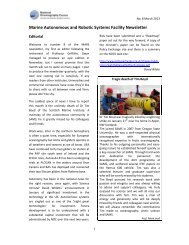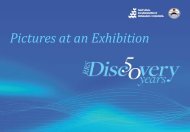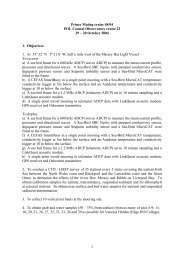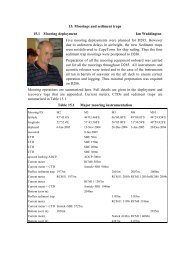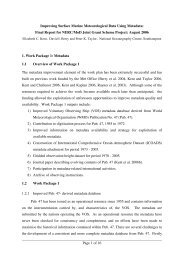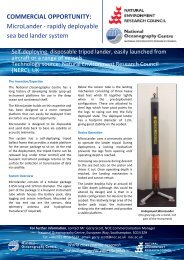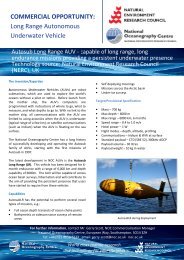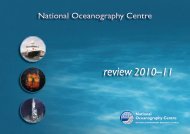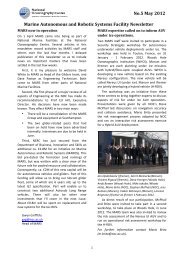Meeting Notes - National Oceanography Centre
Meeting Notes - National Oceanography Centre
Meeting Notes - National Oceanography Centre
You also want an ePaper? Increase the reach of your titles
YUMPU automatically turns print PDFs into web optimized ePapers that Google loves.
NOC Association meeting 26 February 2013<br />
Building on our strengths<br />
Speakers<br />
Professor Peter Liss CBE, FRS, Chair NOC Association Steering Board<br />
Professor Ed Hill OBE, Executive Director, <strong>National</strong> <strong>Oceanography</strong> <strong>Centre</strong><br />
Mrs Jacky Wood, Head, International and Strategic Partnerships Office, NOC<br />
Ms Jo Frost, Science Programme Officer, UKRO<br />
Introductory comments<br />
Presentations from the meeting are on the NOC Association web pages at:<br />
http://noc.ac.uk/noc-association/noc-association-activities<br />
Peter Liss, chair of the Steering Board for the NOC Association, welcomed participants and gave an<br />
overview of the meeting format. He reminded them of the purpose of the NOC Association as a<br />
conduit between NERC, NOC and the wider marine science community<br />
Overview of developments<br />
NERC Strategy<br />
Ed Hill spoke about the new NERC strategy under development which had first been introduced to<br />
the NERC community at a town meeting in Manchester in November 2012. The strategy has the<br />
working title, “The Business of the Environment”. Themes will include discovery science, natural<br />
resources, hazards and environmental change; so much of the focus is around the growth agenda and<br />
societal issues. It is anticipated that the strategy will be made available for consultation with the<br />
community in March/April 2013 and once agreed, will be followed by a detailed implementation plan.<br />
Impact Agenda<br />
NERC is placing increasing focus on how it can more effectively demonstrate the impact of its science<br />
and needs support from the community to achieve this. NERC’s new Director of Innovation and<br />
Communications, Colin McKinnon, has written to the 20 universities who receive the majority of<br />
NERC funding to improve engagement and is also seeking flow of case study examples to help develop<br />
the NERC case.<br />
Recently NERC centres have been undertaking an evaluation process, similar to a REF and are<br />
developing lists of publication outputs and impact case studies. The community needs to improve the<br />
demonstration of the impact of marine science for the sector as a whole; this can be a challenge that<br />
the NOC Association can assist with.<br />
NERC Funding Model<br />
Overall the NERC budget is contracting in real and cash terms. The costs of large infrastructure, e.g.<br />
ships, aircraft and polar research stations are increasing; the rising price of marine fuel is of particular<br />
concern for the marine NC component.<br />
<strong>National</strong> Capability (NC) funding supports large research infrastructure and other NC, for example,<br />
long term science, services and facilities and data. Going forward it is felt to be important that the<br />
1
needs of long term science must be tensioned against the rest of the science spend rather than this big<br />
infrastructure provision.<br />
In the NERC Funding Model, the % funding for Responsive Mode and training stays much the same, but<br />
funding for Research Programmes is increasing. For this there is a need to speed up the commissioning<br />
process. NERC is looking at how a ‘gatekeeper mechanism’ might work where panels support<br />
particular areas of research in order to broaden expertise. Knowledge Exchange is increasingly likely<br />
to focus on specific partnerships. Several of the newer strategic programmes have levered in funding<br />
from other Government Departments, this is a trend which is likely to continue.<br />
Infrastructure<br />
Ships<br />
RRS Discovery is at an advanced stage of fit out, due for delivery later this year and should be available<br />
for science in 2014.<br />
Remotely Operated Vehicle (ROV)<br />
ROV Isis was rebuilt by NMF Sea Systems in 2012 using opportunistic capital facilities. NMF Sea<br />
Systems is also working in parallel with ROV operators across Europe.<br />
Robotics and autonomous systems<br />
As part of the Ministerial focus on ‘8 great technologies’ NERC expects to secure capital funding of<br />
£10m over the next two years for research and technology development of marine robotics and<br />
autonomous systems. Work is underway to identify priorities for using the developing AUV<br />
technology advances to deliver science and how NOC can work with industry to enhance capability.<br />
Marine Science Coordination Committee (MSCC)<br />
Ed Hill presented a slide of MSCC activities. He noted that that the activities of the MSCC have<br />
recently been one theme of the current Parliamentary Inquiry into Marine Science.<br />
Discussion<br />
Kevin Horsburgh (NOC) asked when the Select Committee’s findings would be made public. Ed<br />
explained that report is being prepared at the moment. Based on the evidence provided and<br />
questioning of witnesses he speculated that it could make reference to the cost and operation of<br />
infrastructure, the MSCC role and its delivery and operation across the UK. The Committee had taken<br />
evidence from NERC and industry on the potential for autonomous systems in the future. Other areas<br />
could include the evidence base for marine policy and quality of data for marine seabed and habitat<br />
maps. The question had been raised by the Committee regarding whether the UK should have the<br />
equivalent of NOAA and if not, whether existing coordination mechanisms need strengthening.<br />
Adrian New (NOC) expressed concern about cut backs to NC science in the long term. To enhance<br />
our knowledge of how the ocean system works within the Earth system requires research over a long<br />
time frame. Ed replied that the issues are currently being addressed by NERC Council.<br />
Mark Inall (SAMS) asked how much thought has been given to the REF exercise in the development of<br />
NERC strategy. Ed answered that REF is not an explicit driver in the way that research councils agree<br />
2
funding; however, the Councils want to support the best science possible. NERC doesn’t limit it<br />
funding to the highest graded departments.<br />
David Paterson (MASTS) stated that delivering best science and impact is central to the strategic<br />
delivery of science - staff prioritise research. There are already drivers on universities and centres to<br />
deliver impact. There is a need to for support mechanisms to translate the science, and to recognise<br />
and reward that skill set.<br />
David Marshall (Oxford) asked whether KE/KTP will lever money from industry and if NERC is<br />
assuming that industry will provide more funding Ed replied that not all KE is shown in the red section<br />
of the NERC funding model diagram - impact is being delivered through all the funding streams. The<br />
primary objective of KE funding from NERC perspective is not to lever industry funding as such but to<br />
secure engagements to maximise the impact from NERC’s investments. The delivery of impact is<br />
central to the case for continued investment in science by government. There was a discussion<br />
underway on how NERC’s KE activity it could be targeted most effectively. For example NERC is<br />
looking at the practices of other research councils e.g. BBSRC – industry clubs, e.g. for food security –<br />
as a focus for engaging with the wider community.<br />
Marine Autonomous Systems<br />
Professor Hill presented the context of the discussion. His first slide emphasised that the community is<br />
dependent on ships, and has been ever since the HMS Challenger expedition. However costs are rising<br />
and technologies are maturing so that we may be able to do things differently in the future. Satellites<br />
are good but limited largely to surface observations. Ships are good but have limitations as coverage<br />
tends to only reveal a snap-shot. The World Ocean Circulation Experiment (WOCE) was a 10 year<br />
one off and unlikely to be repeated. There are technical difficulties in collecting high resolution data,<br />
and some places are difficult to access, e.g. under ice. Where large samples and analytical processing is<br />
needed on site, it will be essential to have high power requirements and large instrument packages e.g.<br />
for seismic and drilling. Human intelligence and intervention is also needed at sea.<br />
The next slide documented the beginnings of autonomy. Autonomous systems were used in the<br />
WOCE and today are used e.g. in the ARGO programme. Moorings and observatory systems depend<br />
upon autonomous systems. There have been technological advances in batteries, biogeochemical<br />
sensors, miniaturisation, increased reliability, CTD, telemetry and positioning subsea. UK-led<br />
autonomous marine vehicle developments have resulted in breakthrough science, for example,<br />
exploring under ice sheets and discovering the world's deepest hydrothermal vents etc. For various<br />
reasons the UK industry had not capitalised on this lead e.g. for glider production where the US<br />
industry dominates, however the UK has been an early adopters of gliders and is working on the<br />
sensors to go on to payloads. Unmanned Surface Vehicles (USVs) are emerging technology and there<br />
may be opportunities to develop communication systems with underwater systems, to enhance<br />
mapping capability and rapid deployments. By working with industry, we can generate growth.<br />
There is a need to make autonomous vehicles more available to the marine science community so to<br />
this end, the Marine Autonomous and Robotics Systems (MARS) has been set up at the <strong>National</strong><br />
<strong>Oceanography</strong> <strong>Centre</strong>. We need to engage with a wider set of users – e.g. marine mapping for MCZs,<br />
Defra funding scoping work on use of AUVs to meet regulatory mapping requirements and to engage<br />
with marine industries – those who can help develop, produce and build. There will also be a service<br />
industry needed to maintain and support vehicles with industry applications e.g. CO 2 usage from CCS<br />
reservoirs. This can help the UK industry sector to grow, utilising a hub to pull through new<br />
solutions. In time, it should be possible to develop more ambitious science usage.<br />
3
The importance of fundamental observation was emphasised in further slides. An ideal scenario would<br />
for example to be able to undertake WOCE all day every day. Although fixed moorings can provide a<br />
continuous time series, they are limited to single point data. Can these moorings become ‘mobile’<br />
We want to be able to monitor marine protected areas autonomously and undertake seafloor and<br />
habitat mapping at high resolution and in areas that may be difficult to access. Applications will include<br />
undertaking multi-trophic level surveys – e.g. fish larvae and continuous under ice monitoring. There is<br />
increasing need to be able to complete subsea site investigation, for example, pipeline surveys, seafloor<br />
fluid monitoring and accident investigation. Our community needs joined up observation networks that<br />
communicate and interact.<br />
To start the discussion several questions were posed: Where might autonomous systems transform<br />
our science Should systems come off our ships Is this the best way forward If so, how do we<br />
migrate off ships and use new systems NERC is about to invest capital for observing systems. Our<br />
community should provide input into the design of experiments that can utilise these investments. Can<br />
investment in autonomous systems alleviate the dependence on ships in the longer term If so the<br />
community needs to produce a roadmap.<br />
Geraint West (NOC) advised that there is a paper in production as a business case for autonomous<br />
vehicles and NOC wants to widen out discussion, make existing facilities more robust, with two year<br />
funding as a precursor to the 10 year strategy. Autonomous vehicles are moving to autonomous<br />
systems – this is big science for more than one discipline.<br />
Discussion<br />
Bernie McConnell, SMRU explained that satellite technology is used to monitor marine mammals. This<br />
technology could be used in conjunction with marine mammals as active sensors to measure e.g. fish<br />
stocks.<br />
Tim Jickells (East Anglia) noted that the community cannot second guess what we may want to<br />
measure so will need to use lot of sensors packaged in different ways on different platforms. Gliders<br />
are rather inflexible to future development as they are currently made so we will need to think<br />
differently. Autosub is a big vehicle that can carry development instruments. We need to think about<br />
the overall package – both the payload and adaptability.<br />
Geraint added that a key element is power consumption, power budgeting and management that<br />
contributes to its longevity - the issues are not just about miniaturisation. The batteries used by<br />
Autosub can last between 60 and 70 hours, maybe even up to a week. Autosub Long Range<br />
technology fills a niche between Autosub6000 and gliders. A large vehicle that can take a significant<br />
payload, the Long Range will optimise the approach between a glider and an AUV.<br />
The motor industry does a lot of development work on batteries and NOC is looking to collaborate<br />
with a UK company to enhance battery power, for example, on lithium chloride batteries for<br />
rechargeable cars. We're probably around five years away in terms of getting the power we are<br />
ultimately hoping to achieve.<br />
Henry Ruhl (NOC) advised about the ability to park the Long-Range AUVs on seafloor enhancing its<br />
power efficiency.<br />
David Marshall commented that physical oceanography will always need ships because ARGO is<br />
confined to the upper 2 km. This is an international issue; the roadmap should be scoped in<br />
4
international context. Ed agreed to this point, particularly in relation to gliders. There is a need to get<br />
international engagement and bring in key players, especially from the US.<br />
Patricia Almado-Villela (MMO) asked about building up the community. For example, involving Defra,<br />
DECC, Marine Scotland in enhancing partnerships with developers to help deal with issues. A funding<br />
partnership could look at how to bring together seabed habitat mapping, existing industry<br />
infrastructure and vessels that serve the platforms. MILG is looking at possibilities.<br />
Steve de Mora (PML) expressed concerns on replacing mooring sites; users such as the Met Office<br />
depend on the fixed point nature of the sites. Ed commented that this is not a panacea and sometimes<br />
we do need fixed point measurements, however, it may be possible to interrogate data from<br />
moorings differently; currently we are dependent on surface buoys to transmit data but perhaps we<br />
could replace these with subsea moorings and use wave gliders to interrogate them. Alternatively,<br />
could we replace moorings altogether Perhaps it might be possible to try these systems in parallel<br />
with autonomous systems, for example, repeat hydrography on the extended Ellett line. At the<br />
moment, we cover this area by ship every three years – a glider might be able to do this every day.<br />
The PAP long term deep-sea observatory is part of international EuroSites network - could all of this<br />
be replaced with autonomous systems We need to ensure that the roadmap matches our needs. It<br />
can involve radical thinking on a 10 year timescale.<br />
Mark Inall said that it would be important to monitor where observations will have most impact – at<br />
the moment, fixed moorings can’t achieve this. We need to have a system that will make the best<br />
improvement in modelling and forecasting.<br />
Stuart Rogers (Cefas) raised the issue of implementation of European Directives and the problems to<br />
be addressed in European or regional seas. Which of the 11 MSFD descriptors can be done<br />
autonomously Russell Wynn (NOC) advised that for the new FP7 programme DEVOTES project,<br />
there is a suite of technologies that might be used for MSFD. There is an MSCC/UK-IMON workshop<br />
in September on this issue: Dates are 10-12 September 2013 at NOC in Southampton.<br />
A question was raised about the role of instruments in biology and chemistry applications – the ongoing<br />
need to collect water samples. Colin Brownlee (MBA) explained that there are many biological<br />
and optical probes for biological processes. There needs to be a synthesis of what they can do – flow<br />
cytometry, micro sensors, acoustic sensors – these are all possible.<br />
Cameras used on Autosub can produce high resolution images of the seabed which can be assembled<br />
into mosaics of images of the deep ocean and shelf. Autosub can collect data comparable with that<br />
taken from ships, for example, photos of habitat that are repeatable. As part of Dr Wynn’s role as<br />
Chief Scientist of MARS he intends to produce a brochure of the capabilities and capacity of vehicles<br />
and include case studies where we are pushing the boundaries in using this technology.<br />
Steve Hall (NOC) noted that although development of technology is fast, it is important to always<br />
address the related policy and legal issues, insurance, flag of registration etc, going into other EEZs etc.<br />
John Bull (Southampton) noted that EPSRC is doing a lot of work on autonomy and robotics. Are<br />
NERC and EPSRC linked up in regard to this Ed responded yes there have been discussions; the<br />
funding anticipated for new autonomous vehicles is within an ESPRC coordinated bid. Geraint West<br />
added that Herriot Watt is coordinating a special interest group and there is a new initiative with the<br />
Marine Industries Leadership Council.<br />
5
There was uncertainty as to whether EPSRC is leading on training engineers. Adequate training<br />
provision will also be a concern going forward.<br />
Ed commented that whilst capital budgets have been cut NOC has been supplementing to some extent<br />
by optimising on ad-hoc capital opportunities. We must maximize this opportunity to build the base to<br />
attract more capital engagement for the longer term; having the baseline needs and a strategic plan<br />
would facilitate this.<br />
Geraint explained that, in collaboration with the Technology Strategy Board and others, there has<br />
been a competition for funding for a long endurance surface vehicle, from existing monies. There<br />
have been six concept studies of about £50k each and TSB are expecting to take forward development<br />
of two. The vehicle requirements include maintaining slow speed for up to three months, and<br />
covering a 100nm transit there and back. Once on station, it should be able to can operate a winch or<br />
other equipment.<br />
Mark Inall referred to the international context and the FP7 GROOM glider network for operators<br />
integrated approach; there is a need for a science driven programme to operate alongside the<br />
programme. Was there a need to influence how science driven projects might come forward<br />
There has been an idea to attempt to repeat the HMS Challenger expedition using gliders - Rutgers is<br />
leading. The RAPID array is mooring and ship dependent - we have started to use gliders here<br />
although MAS technology might be used instead. Ed noted that South Africa has an impressive glider<br />
facility developed because of restrictions on the availability of ships; a demonstration that communities<br />
can do leading edge work already around real science questions. A transect may be completed from<br />
South Africa to Australia shortly and it is likely to be open to UK participation.<br />
Ed raised the question about the type of science we are currently doing that we might, in the future,<br />
do using MAS technology, albeit with possible overlaps. There are long term science and observing<br />
programmes, for example, the extended Ellett line and the RAPID array at 26˚N which are ship<br />
dependent. The AMT programme used ships of opportunity initially but now uses dedicated research<br />
cruises. It might be possible, by using biogeochemical sensors to complement the AMT, as a<br />
demonstrator activity Ultimately, it may even be possible to replace the PAP mooring.<br />
Henry explained that there will be breakthroughs in next couple of years, for example, adding<br />
carbonate system sensing for pH and CO 2 simultaneously which negates, in some cases, the need for<br />
water samples. There will be advances in holographic imaging which can be relayed to shore and it will<br />
be possible to capture images of zooplankton and phytoplankton.<br />
Kevin Horsburgh (NOC) referred to surface flux analysis and parameters for climate modelling, noting<br />
that AUVs can be programmed to fly under the satellite tracks; facilitating ground truthing.<br />
David Marshall added that the WOCE and CLIVAR committees know the science drivers and we need<br />
to look also to the atmospheric community and must not forget the modelling capacity. The UK has<br />
strong capacity via the <strong>National</strong> <strong>Centre</strong> for Ocean Forecasting (NCOF).<br />
Peter Liss mentioned high data flow noting that we can learn from the Met Office community. There<br />
needs to be efficient storage and access and development of data products derived from autonomous<br />
measurements – this also needs resource. We need advances in data manipulation, data products and<br />
handling. There is a concern that NERC resource for data etc is decreasing. Ed commented that these<br />
concerns are why we need partnerships – there must be a collective effort, especially if working on an<br />
international scale.<br />
6
Bernie asked about data processing, how much data should be processed on board and what we need<br />
to collect. There can be a tendency to do processing on board and then just pass on the products.<br />
Patricia noted that there are issues about not using or sharing existing data and also how well we deal<br />
with the issue of metadata.<br />
John Shears (BAS) commented on the potential big opportunities to use AUVs under sea ice. The<br />
NERC Arctic research programme community need to know about MARS. There are big technical<br />
challenges ahead, for us and industry, for example, the blow-out of oil spill under ice – this is a case<br />
where we could use AUVs to monitor situations. We need the capability for rapid response and even<br />
to deploy from the air.<br />
Ed agreed that there is interest in these areas, also in the use of AUV for undertaking krill surveys –<br />
e.g. in Norwegian fields initially. Ice fields can prove difficult for ships to access, are vast areas and<br />
currently, there is a paucity of data. The way forward will be through continuous engagement with<br />
the community.<br />
Development of European Initiatives<br />
Jo Frost UKRO the UK Research Office in Brussels<br />
Jo Frost gave a presentation about the Horizon 2020 proposal, the EU’s new programme for research<br />
and innovation and explained the different funding mechanisms (see detailed slides).<br />
Jacky Wood (International and Strategic Partnerships Office, NOC)<br />
Jacky Wood gave a presentation on the Joint Programming Initiative (JPI Oceans), a coordinating and<br />
integrating platform for marine and maritime research (see slides). Work is under way to develop a<br />
Strategic Research and innovation agenda by the end of 2014. There needs to be an identification of<br />
pilot actions to test the process.<br />
For both activities the focus of advocacy so far has been in raising the profile and context of research<br />
areas of interest to the marine science community and ensuring that within the areas of societal<br />
challenge the potential contributions of marine science are understood. The next stage is to inform<br />
the development of the more detailed work programmes and texts for calls for proposals: We need to<br />
hear from the community what their priorities are in more detail.<br />
Discussion<br />
Jon Bull asked Jo about success rates, especially for the European Research Council. Jo replied that<br />
success rates are around 12 - 15% for PIs from the UK, ERC Synergy grants have only a low success<br />
rate because they are open to any research area.<br />
Patricia asked whether the social aspects of projects will be considered as well as management<br />
activities. Ecosystem services are a key area - the MMO is an end user of science.<br />
David Paterson queried whether there will be advice available on the involvement of SMEs. Rates of<br />
overhead recovery will also be an issue going forwards.<br />
7
Regarding reimbursement rates, the Commission has proposed a fixed rate model for overheads.<br />
Despite UK protests this is likely to be the model decided; though UKORO understand there is some<br />
discussion still around rates for infrastructure initiatives. Jo Frost added that VAT should be reclaimable<br />
in Horizon 2020. If management costs are no longer reimbursed at 100% rate, UK<br />
organisations may be less keen to lead.<br />
NOC Association activities<br />
Jacky Wood gave a short overview of activities (see slides) The NOC Association has produced<br />
monthly newsletters and is populating the website with copies of meeting papers and Association<br />
activities. A draft ‘Grand Challenges’ leaflet was issued to delegates and initial comments invited so that<br />
a final version could be produced. Briefing documents on key societal areas and the contribution of<br />
marine science are also in production and additional impact case studies are invited.<br />
Work to develop the ‘compendium’ would start shortly; this was now of increasing importance in the<br />
context of MSCC. It would scoping the UK marine science community – research areas, core skills,<br />
courses etc. – leading to ‘compendium of capability’. A question was raised whether the analysis of<br />
capability could be broadened to include relevant social sciences.<br />
The Association would also be involved in developing the roadmap of ‘technology for 21 st century<br />
marine science’. NOC ISPO staff were facilitating the first meeting of the new Marine Facilities<br />
Advisory Panel later that day.<br />
Jacky Wood also presented a preliminary analysis of the response to the fieldwork survey; this was<br />
based on returns submitted in a very short timescale; a fuller analysis and report will be completed and<br />
announced via the Association’s website.<br />
In response to an invitation from the Chair to give an update on the situation at the field station at<br />
Millport David Paterson said that HEFCE funding has now been withdrawn and it seemed likely that<br />
Millport would have to close in December 2013. The site’s infrastructure was in need of<br />
modernisation. The Scottish Funding Council is currently looking at options. MASTS is also looking at<br />
the provision of marine training in Scotland if Millport closes.<br />
A question was asked as to whether the value of fieldwork on the NERC ships has been quantified. Ed<br />
replied that it hasn’t and that it would be difficult to quantity although the importance of research<br />
cruises as a way to train and sustain the marine science community should be recognised.<br />
More generally in the suite of national and international activities the focus for the Association was to<br />
improving influence and visibility (Europe, Government Departments though MSCC, NERC and other<br />
Research Councils and to growing the Network for the NERC funded marine science community and<br />
interface to ‘stakeholders’<br />
Peter Liss asked if there is anything else the Association should be doing. In answer to a question<br />
about how today’s discussion would be disseminated, Jacky Wood answered that the meeting note<br />
would be published on the web site and its availability announced via the NOC Association newsletter.<br />
Peter Liss acknowledged the role of the ISPO team in enabling the meeting and thanked delegates for<br />
attending.<br />
International and Strategic Partnerships Office<br />
March 2013<br />
8



